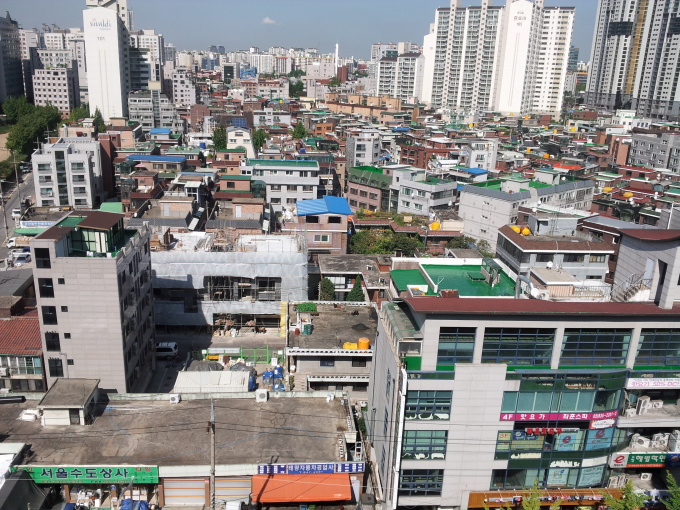[서울=뉴스핌] Reporter Lee Dong-hoon = The government and the ruling party are seeking ways to increase housing supply in the Seoul area by easing changes in residential use. Specific measures, such as the floor area ratio upper limit and the distribution method of development profits, are expected to be included in the’innovative supply policy’ announced before the Lunar New Year holidays.
The floor area ratio (the ratio of the total floor area to the land area) generally increases by 200% or more when the use change regulation is relaxed mainly in the station area. Excluding donations, etc., the number of households doubles or more in the same area when calculated simply. Main targets include 300 subway stations in Seoul and low-rise multi-family villas. However, there are also observations that it will be difficult to speed up supply because most of the buildings have many stakeholders such as tenants and renters.
◆’Innovative supply countermeasures’ promoted to double the floor area ratio by changing usage
According to the political and real estate industry on the 12th, in order to expand the supply of housing, Seoul is seeking a plan to supply large-scale housing by changing the use of general residential areas to semi-residential and commercial areas and semi-industrial areas to residential areas.
In the meantime, the standards have been strict, such as whether it is adjacent to roads and commercial facilities, or whether it is necessary to undergo deliberation in order to change its use, but it will be used to secure supply by mitigating this. Hong Ik-pyo, chairman of the Democratic Party’s Policy Committee, said on KBS Radio on the day that “we are discussing measures with the Ministry of Land, Infrastructure and Transport to dramatically increase supply to the metropolitan area centered on Seoul through high-density development or use change.”
If the usage area is applied upward, the legal floor area ratio upper limit increases. This policy is in line with the high-density development of the station area proposed by Minister of Land, Infrastructure and Transport by Byeon Chang-heum as a housing supply plan.
According to the current urban planning ordinances of Seoul, the upper limit of the floor area ratio for Class 2 general residential areas is 200%. If this residential area is repurposed into a quasi-residential area, the floor area ratio can be increased up to 400%. If it is changed to a commercial area, it is possible to 800% of the general area and 1000% of the central area. Even with a simple calculation, the floor area ratio is at least twice as high as the usage change is increased.
Of course, not all regions have these benefits. It is promoted by conducting projects with public institutions such as Korea Land and Housing Corporation (LH) and Seoul Housing and Urban Corporation (SH). It is a device to redeem some of the development profits. In addition, building a new middle-rise or higher building requires a lot of design and construction costs, and there is an intention to speed up the project by supporting this part by public institutions.
The area around the station area and low-rise, low-density multi-family and villas are the first candidates. The average floor area ratio around 307 subway stations in Seoul is around 160%, and raising it to more than 600% is more likely to cause breathing in housing supply. The location around subway stations can also attract stable demand.
If the use of low-rise and low-density areas is changed to a semi-residential area or a business area, the floor area ratio will increase significantly. There is room for more supply than those developed above the middle class. In the industry, the development of semi-industrial areas where low-density buildings and factories with three stories or less, such as Yeongdeungpo, Geumcheon-gu, and Seongdong-gu areas, are expected to be applied first.
◆ More than 10,000 households can be supplied to Seoul…The speed of the project is unknown due to many stakeholders
If high-density development is settled in the market quickly due to the increased floor area ratio promoted by the party government, it is calculated that Seoul can supply more than 10,000 new apartments. The Ministry of Land, Infrastructure and Transport and the city believe that there is room for promotion in about 100 stations in the station area and in low-density development areas on the 2nd and 3rd floors. Of these, if only 500 households are supplied in each of 30 regions, 15,000 households can be created.
 |
| Low-density residential area around Yeongdeungpo, Seoul |
The problem is the speed of the business. This month, the Ministry of Land, Infrastructure, and Transport plans to finalize an amendment to further increase the floor area ratio and ease restrictions on use change with the enforcement decree of the’National Land Planning and Utilization Act’. Criteria related to change of use are determined, and there are considerable steps to be taken from the decision of the business method, selection of candidate sites, design, relocation, start of construction, and completion. Even if a candidate site is selected this year, it is expected that it will be possible to move in after 4-5 years.
The fact that most of the shopping malls and villas have many stakeholders is another homework to be solved. Even if the owner repurposes and tries to build a new building, it is difficult to implement the business right away if there are tenants or renters in operation. It means that it is a business that requires a considerable amount of time to recruit and move in. In addition, since it is a project conducted with public institutions, it is difficult for the owner to exercise property rights during development. The distribution of development profits is also likely to cause friction.
Professor Hong Chun-wook of Sejong Cyber University said, “If the subway station area and low-density buildings are used as areas where the floor area ratio increases, it is expected that new housing can be increased, thereby helping to stabilize housing.” “Since there are many people involved, it remains to be seen whether such a plan to expand housing supply will be secured in the market.”
–


